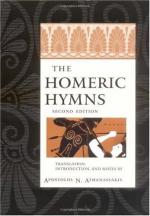Conceptions originally “half-conscious,” and purely popular, as of a Spirit of Vegetation, incarnate, as it were, in each year’s growth, were next handled by conscious poets, like the author of our Hymn, and then are “realised as abstract symbols, because intensely characteristic examples of moral, or spiritual conditions.” {72} Thus Demeter and Persephone, no longer pigs or Grain-Mothers, “lend themselves to the elevation and the correction of the sentiments of sorrow and awe, by the presentment to the senses and imagination of an ideal expression of them. Demeter cannot but seem the type of divine grief. Persephone is the Goddess of Death, yet with a promise of life to come.”
That the Eleusinia included an ethical element seems undeniable. This one would think probable, a priori, on the ground that Greek Mysteries are an embellished survival of the initiatory rites of savages, which do contain elements of morality. This I have argued at some length in “Myth, Ritual, and Religion.” Many strange customs in some Greek Mysteries, such as the daubing of the initiate with clay, the use of the [Greek text] (the Australian Tundun, a small piece of wood whirled noisily by a string), the general suggestion of a new life, the flogging of boys at Sparta, their retreat, each with his instructor (Australian kabbo, Greek [Greek text]) to the forests, are precisely analogous to things found in Australia, America, and Africa. Now savage rites are often associated with what we think gross cruelty, and, as in Fiji, with abandoned license, of which the Fathers also accuse the Greeks. But, among the Yao of Central Africa, the initiator, observes Mr. Macdonald, “is said to give much good advice. His lectures condemn selfishness, and a selfish person is called mwisichana, that is, ‘uninitiated.’” {74a}
Among the Australians, Dampier, in 1688, observed the singular unselfish generosity of distribution of food to the old, the weak, and the sick. According to Mr. Howitt, the boys of the Coast Murring tribe are taught in the Mysteries “to speak the straightforward truth while being initiated, and are warned to avoid various offences against propriety and morality.” The method of instruction is bad, a pantomimic representation of the sin to be avoided, but the intention is excellent. {74b} Among the Kurnai respect for the old, for unprotected women, the duty of unselfishness, and other ethical ideas are inculcated, {74c} while certain food taboos prevail during the rite, as was also the case in the Eleusinia. That this moral idea of “sharing what they have with their friends” is not confined merely to the tribe, is proved by the experience of John Finnegan, a white man lost near Moreton Bay early in this century. “At all times, whether they had much or little, fish or kangaroo, they always gave me as much as I could eat.” Even when the whites stole the fish of the natives, and were detected, “instead of attempting to repossess themselves of the fish, they instantly set at work to procure more for us, and one or two fetched us as much dingowa as they could carry.” {75} The first English settlers in Virginia, on the other hand, when some native stole a cup, burned down the whole town.




